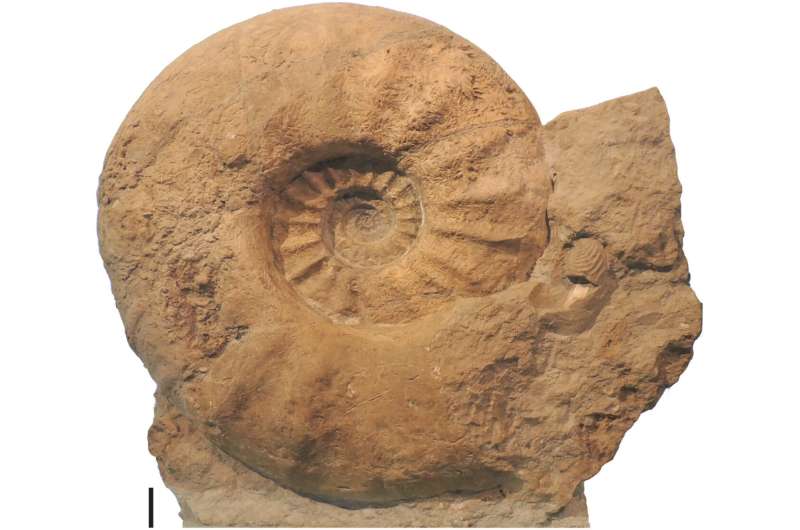November 11, 2021 report
Study of giant ammonites suggest they grew large because their predators grew large

A small team of researchers from Germany, Mexico and the U.K. has found evidence suggesting that the reason a species of ammonite grew into giants was because of the increasing size of the mosasaurs that fed on them. In their paper posted on the open-access site PLOS ONE, the group describes their detailed study of 154 specimens of two species of ammonite fossils and what they learned about them.
Ammonites are a kind of coil-shelled mollusk that went extinct millions of years ago. They were notable for their distinctive frilled suture lines. Prior research has shown that the average ammonite was no more than half a meter in diameter. But one species stands out—Parapuzosia seppenradensis, a species that could grow to have a diameter as large as 1.5 to 1.8 meters. In this new effort, the researchers sought to discover why it was that P. seppenradensis grew so large.
The approach by the team was to first learn more about ammonites in general—to that end they collected 154 specimens from various institutions, all of which were of two species: P. seppenradensis and Parapuzosia leptophylla. As part of their effort, they found evidence that suggested P. seppenradensis evolved from P. leptophylla after P. leptophylla began migrating from the coastlines of what is now western Europe to the shores of what is now the Americas.
After a split occurred, P. seppenradensis began to get bigger. The researchers were not able to find any conclusive evidence to explain why they began to grow, noting that it could have been due to events such as changes in climate. But they did find that many species of mosasaurs began to grow bigger at around the same time. The large marine reptiles are believed to have been the main predators of ammonite. The researchers suggest the reason P. seppenradensis began to grow was because the larger they were the more difficult it was for the reptiles to fit them in their mouth—those that were bigger survived to reproduce.
The researchers acknowledge that there is one kink in their theory—prior research has shown that as P. seppenradensis reached its peak size, mosasaurs continued to get bigger. And after a while, P. seppenradensis began to get smaller again for unknown reasons.
More information: Christina Ifrim et al, Ontogeny, evolution and palaeogeographic distribution of the world's largest ammonite Parapuzosia (P.) seppenradensis (Landois, 1895), PLOS ONE (2021). DOI: 10.1371/journal.pone.0258510
Journal information: PLoS ONE
© 2021 Science X Network





















